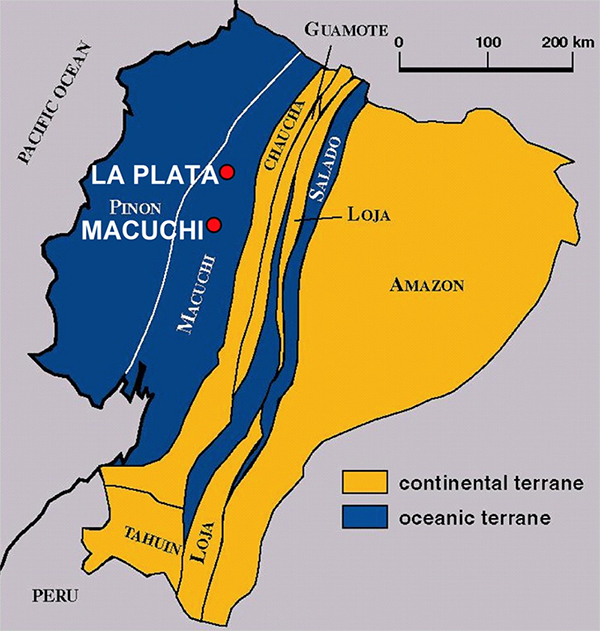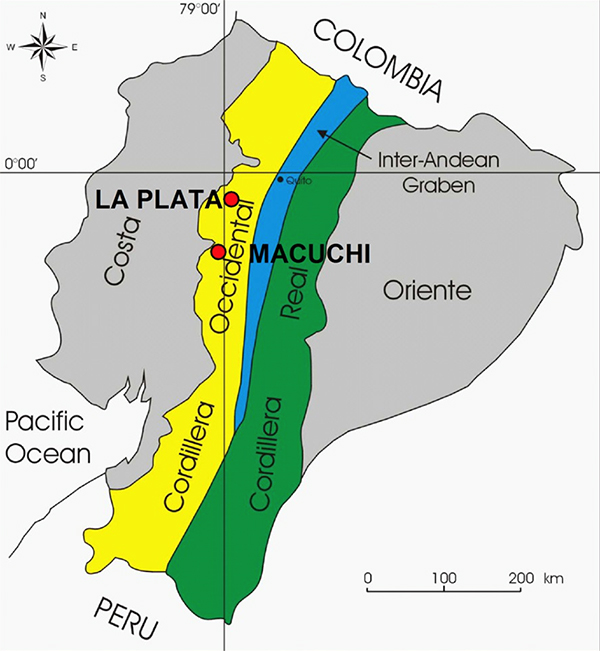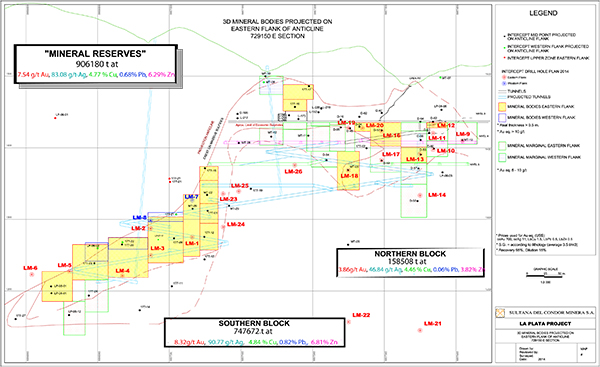Geology & Mineralization
Regional Geology
The La Plata deposit is an Eocene high-grade gold enriched, copper, zinc and silver VMS deposit, that appears to be similar to the Noranda /Kuroko-type VMS deposits. The deposit lies along the western flank of the Cordillera Occidental, a Cretaceous and Paleocene island arc environment comprising a submarine volcano-sedimentary sequence of basaltic to andesitic composition.
The western flank of the Cordillera Occidental hosts numerous VMS deposits of which La Plata is one of the most important. The entire 100-km VMS trend remains under explored and hosts significant potential for numerous Noranda-like mineralized lenses and deposits.
Project Geology
The La Plata property is hosted by a sequence of predominantly basaltic to andesitic volcanic and volcano-clastic rocks constituting the Eocene portion of the Macuchi Unit in the western flank of the Cordillera Occidental.
The mineralization encountered at La Plata is characterized as a gold-rich polymetallic VMS Noranda/Kuroko-type deposit. The mineralization occurs as lenses of pyrite, chalcopyrite and sphalerite with minor bornite, galena, tennantite, chalcocite, covellite and native gold in a gangue of quartz, sericite, and barite.
The La Plata VMS deposit comprises of the La Mina South block, and the La Mina North block, both striking in a north-south orientation. The La Mina South block and the La Mina North block are separated by a late sub-vertical fault zone.
The volcanic and sedimentary sequence in the central and northern part of the La Mina blocks have been intruded by at least two different stages of late dykes, the coarse-grained rhyodacite and the fine to medium grained pyroxene-phyrric gabbro dykes.
In addition to the mineralization known at the La Mina deposit, at least 14 other key exploration targets have been identified along a 6-km trend of the La Plata favorable stratigraphy.
VMS Zones
The VMS mineralization consists of primarily stratabound lenses of massive, typically fine grained, sulphide-barite mineralization up to 10 meters thick. Upper contacts are generally knife sharp with the marker horizon mafic volcaniclastic or chert/jasper units.
Mineralization consists of pyrite-chalcopyrite-sphalerite-galena-barite, with accessory bornite±covellite-chalcocite and sulphosalts. Within the sulphide sequence, there is evidence of some weak vertical zonation, and overprinting of sulphide mineralization and remobilisation is common within and peripheral to the massive sulphide lenses.
Lower contacts are usually gradational into stockwork zones or disseminated sulphides, with similar mineralogy to the VMS lenses, albeit of a lower tenor of grade.
Two stages of gold are inferred. The first is associated with the primary deposition of massive sulphide mineralization, and the second is a much younger overprinting phase associated with quartz veining.
The VMS bodies strike in a north-south orientation, and dip between 80° and 45° towards the east, with an overall strike length of 620m, and an average ‘flattened’ width of ~250m.
Small-scale mining in the mid-1970’s and early 1980’s exploited a small portion of the La Mina North block, mainly focussing on visible copper mineralization.
High Grade Results from Previous Drilling
| Hole | Width (m) | To (m) | m | Au (g/t) | Ag (g/t) | Cu (%) | Zn (%) | Pb (%) |
| CMLP-17-93 | 339.43 | 353.34 | 13.91 | 3.51 | 64.24 | 0.59 | 4.11 | 0.85 |
| CMLP-17-79 | 50.25 | 62 | 11.75 | 5.12 | 67 | 3.33 | 9.12 | 2.09 |
| including | 52.37 | 62 | 9.63 | 6.09 | 80 | 3.96 | 11.10 | 2.51 |
| CMLP-17-49 | 62.26 | 74.46 | 12.20 | 4.07 | 27.00 | 5.79 | 1.80 | 0.29 |
| including | 62.26 | 68.54 | 6.28 | 7.12 | 24.00 | 8.84 | 1.61 | 0.36 |
| CMLP-17-56 | 11.16 | 30.42 | 19.26 | 4.02 | 34.24 | 6.53 | 5.10 | 0.27 |
| including | 16.22 | 27.00 | 10.78 | 6.35 | 54.32 | 9.64 | 8.70 | 0.43 |
| CMLP-16-18 | 64 | 71.34 | 7.34 | 3.43 | 21 | 1.34 | 3.90 | 0.47 |
| 87.83 | 91.23 | 3.4 | 1.27 | 14 | 1.50 | 2.52 | 0.19 | |
| 120.71 | 123.63 | 2.92 | 1.49 | 14 | 1.67 | 1.59 | 0.14 | |
| CMLP-16-25 | 75 | 81.65 | 6.65 | 1.17 | 30 | 0.29 | 3.13 | 0.48 |
| CMLP-17-38 | 119.3 | 133 | 13.7 | 1.49 | 31 | 5.63 | 1.32 | 0.11 |
| including | 119.3 | 122.88 | 3.58 | 2.38 | 93 | 15.92 | 2.31 | 0.16 |
Longitudinal Block Model



